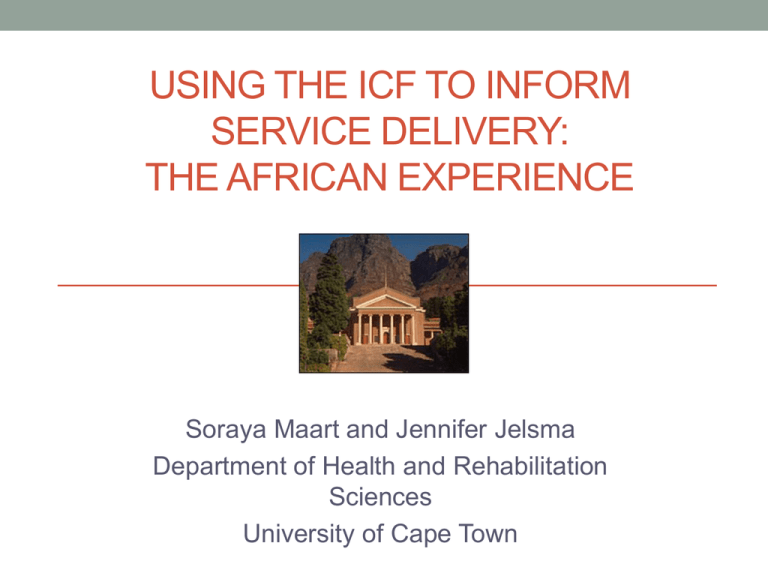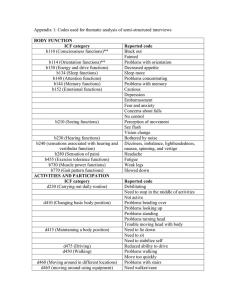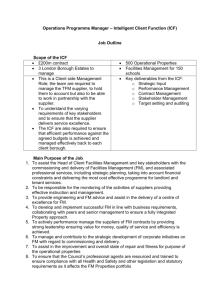USING THE ICF TO INFORM SERVICE DELIVERY: THE AFRICAN EXPERIENCE
advertisement

USING THE ICF TO INFORM SERVICE DELIVERY: THE AFRICAN EXPERIENCE Soraya Maart and Jennifer Jelsma Department of Health and Rehabilitation Sciences University of Cape Town Introduction • Africa is a continent of great contrasts in terms of resources and health care availability. • The limited health care resources in the public sector require innovative measures be taken to adequately address the quadruple burden of disease, and the marginal impact being made on the health related Millennium Development Goals (MDG). • Due to the advancement of medical interventions mortality rates have reduced, with an increase in morbidity and persons living with disability. Background • In August 2011, The SA Department of Health released its Green paper on the planned NHI policy to be implemented in 2014. • In its Medium Term Strategic Framework it proposes the re-engineering of the PHC approach to ensure access to health services for all. • However the value of rehabilitation in improving life expectancy or the quality of life among South Africans does not appear to be appreciated • Rehabilitation services are not explicitly incorporated into the overall service scheme. Background One of the reasons for the exclusion of rehabilitation services could be the lack of data related to the prevalence and impact of disability. • Developing countries have poor information systems and are still having trouble in getting accurate morbidity and functioning data. • Consequently, the impact of functioning is not adequately factored into the BoD, and BoD studies tend to rely on secondary data and extrapolation of mortality data (Bradshaw, 2003) Aims of the presentation As highlighted in the World Report on Disability, data on the needs of people with disabilities, both met and unmet, are important for the implementation of policy and programmes to ensure an inclusive society (WHO, 2011). This presentation presents the efforts made in South Africa and Rwanda to meet this information gap, through the use of the ICF. It will provide examples of attempts made to implement data collection within •the public sector for policy formulation, • an institutional setting for patient management and •in the community to assess policy implementation. In addition, as HIV is of such concern in the Sub Saharan region, the results of different community surveys of functioning in HIV and the policy implications of these will be discussed. The Public Sector of SA • In 2008, the DoH wished to improve data available on functioning and commissioned the training of rehab workers across the provinces. • Rehabilitation professionals underwent training in the conceptual framework, possible uses and coding of the ICF • However, the training was perceived to be superficial and participants were still not confident to engage with ICF • A pilot study was instigated and a data collection form was developed Public sector – Tertiary hospital • Two year delay from training to piloting • Took one and half hours to complete the form on known • • • • • • patients Staff struggled with the qualifiers and environmental and contextual factors Debate regarding treating patient vs completing a form for 1.5hours Staff did not understand the bigger picture For stats purposes, head counts are the most important No information system available to capture data obtained. The staff viewed the coding as extra work Rehabilitation Institution • Staff used ICF approach in patient assessment to change • • • • from a provider driven system to a patient driven system Assessment parameters were defined by: - the discharge environment and - the functional skill requirements for re-integration Multi disciplinary approach was essential This approach showed reductions in overall length of stay – having financial benefits to the institution and state. The ICF conceptualization was used in the development of the CECRI (Client enablement and community reintegration pogramme)- no codes used Outcome Levels •0 Physiologic instability •I Physiologic stability • II Physiologic maintenance • III Residential reintegration • IV Community reintegration •V Productive activity Landrum PK, Schmidt ND, McLean A (ed) (1995) Outcome-oriented Rehabilitation, Aspen Publishers, Inc, Gaithersburg Use of the CECRI: • Barriers to community • LEVEL 4 & 5 reintegration/enablement • Resources/Facilitators • Social/Community • reintegration • ADL’s Mobility • • Body Function • • Post Discharge MX LEVEL 3 & 4 LEVEL 2 LEVEL 2, 3, 4 & 5 Community study– Urban and rural environmental factors • In South Africa, all people with disabilities should receive • • • • a disability grant of approx $100 per month It is national policy that all buildings should be accessible to all people There is a national policy (NIDS) of moving towards inclusion of PLWD at all levels, education as well as employment There is a big divide in the income levels and employment possibilities between urban and rural dwellers Study was undertaken to establish whether these policies are being implemented Policy implementation • The specific objectives were to identify whether policies related to access where being implemented and whether the barriers were different for those living in the Eastern and Western Cape of South Africa. Policy implementation • 244 rural and 61 urban respondents with disabilities were identified through a snowballing technique. 45% were male. • The ICF checklist was used to establish the environmental barriers experienced by the participants % Reporting problems Type of Barrier: Eastern Cape Western Cape chi square p-value 13.0 25.5 9.2 0.002 E115 daily living 23.7 28.9 1.1 NS* E120 mobility 29.5 41.8 5.4 0.02 E125 communication 24.5 34.0 3.6 0.06* E150 Public Buildings 27.7 54.1 24.5 <0.001 E155 Private Buildings 24.5 38.1 7.2 0.007 Mean % reporting 23.8 37.0 4.0 .046 Products and technology E110 eating & medicine problems Natural environment and human made changes to the environment Results Type of Barrier: Eastern Cape Western Cape chi square p-value E525 Housing 25.2 42.9 11.8 0.001 E535 Communication 26.0 29.2 0.4 NS* E540 Transport 27.4 26.8 0.02 NS* E550 Legal 18.1 38.1 17.9 <0.001 E570 Social Security 22.1 24.5 0.3 NS* E575 Societal Support 18.6 14.3 1.0 NS* E580 Health 12.9 12.2 0.03 NS* E585 Education 34.7 45.9 4.2 0.04 E590 Labour 42.7 47.4 0.7 NS* Mean % problems 25.3 31.2 0.89 NS* Services Accessibility • More than 50% of the urban sample reported barriers with access to public buildings. • Study was done 7 years after the publication of the Integrated National Disability Strategy (INDS) of South Africa, which specifically recommends that the National Building Regulations be amended to allow barrier-free access to all buildings. Employment and education access • More than 40% of both samples reported barriers to employment • 35% of rural and 46% of urban respondents reported barriers to education. • Universal access to employment and education is clearly not yet implemented. There was, however, no difference between the income of the respondents with disabilities and a control group consisting of their neighbours. The Disability Grant system seems to be working. Lessons learnt • Policy implementation needs to be constantly monitored and the environmental section of the ICF can be utilised to good effect • The use of the ICF checklist made identification of different barriers possible. • Although the information gained was very useful and made intuitive sense, the checklist does not adequately specify the items and a derived instrument should be used in the future. Services for PLWHIVA • Rwanda and South Africa are among the ten countries in Sub-Saharan Africa most severely affected by the pandemic of HIV/AIDS (WHO, 2005). • For most people who are able to access and tolerate ART, HIV has become a chronic condition characterised by cycles of illness and wellness (Rusch, et al., 2004). • There have been several studies on the functional status of people living with HIV. Each of these had policy implications. Studies -Rwanda • Problem is that patients report • • • • monthly for medication but do not get referred on to other services that they might require. Aim of the study was to identify the functional needs of PLWHIV in order to develop appropriate referral pathways within Based on ICF checklist and published data to develop the impairment set Used WHO-DAS II for functional limitations in HIV. Fifteen health centres throughout the country were visited between June and August 2010. 502 questionnaires were completed and were included in analysis Results • The most common problems reported were “Doing things for relaxation or leisure” (84%), fatigueability (83%), Pain (63%) and “Standing for long periods” (53%). • CHAID analysis indicated that the impairment of discomfort with sexual intercourse was most strongly associated with “doings things for relaxation” • Further analysis indicated that the ability to stand for a long time was found to be associated with joint mobility, skin sensation, memory functions and muscle strength. Lessons learned • The use of the ICF resulted in a data set that can and will be used to raise the awareness of health workers of the functional problems associated with HIV • As intended, the ICF will enable inter-disciplinary and multi-disciplinary discourse around these issues to take place. Combined results of three studies • The results of four studies on HIV were combined into a single paper. These were done before anti-retroviral therapy was available in SA. • Mostly gay population in Brazil – all on ARVs • People in early stages of HIV in South Africa – no ARVs or limited access • Mine workers in SA who were given ARVs by their employers • Patients admitted to hospital with AIDS Results • Common problems experienced in all groups related to • • • • weight maintenance, Mental functions presented the most problems in all groups, with sleep (50%, 92/185), energy and drive (45%, 83/185), and emotional functions (49%, 90/185) being the most affected. In those on long-term therapy, body image affected 93% (39/42) and was a major problem. The other groups reported pain as a problem, and those with limited access to treatment also reported mobility problems. Cardiopulmonary functions were affected in all groups. Results • The long-term ARV group reported few activity limitations but a greater number of participation restrictions than the other two groups. • The group in full time employment on ARVs reported the least problems in all areas • The hospitalised group reported the most problems in impairments and activity limitations. Lessons learned • The dramatic impact of ARVs on the functioning of PLHIV was clearly demonstrated by these studies. As the provision of ARVs was still controversial in SA, this was an important finding with considerable policy implications. • The use of the ICF codes enabled comparisons across countries and across languages (English, Xhosa, Sotho and Portuguese) • The impact of environmental factors (e.g. the availability of appropriate products, medication) on functioning was obvious. • The limitation of simply recording health condition (HIV) was highlighted as the presentations of the groups were so different. Conclusion • These two studies showed that the ICF was effective in identifying the main problems associated with HIV/AIDS as well as the impact of access to ART. • This type of data could be used to advocate for the mandatory access to ART as well as the inclusion of respective health professionals in the multi disciplinary team approach to care. Conclusions of presentation • ICF has been used to collect varied and useful information • Data collection seems to be useful when it is undertaken for a specific purpose, such as in the community surveys, as part of a time defined study. • Unless there is buy-in from those who do the data collection and unless this data is collated and channelled back to the users and service providers, routine data collection for statistical purposes is unlikely to be successful. Acknowledgements • University of Sydney and the University of Cape Town • Lionel Naidoo- Assistant Director Groote Schuur Hospital • Mansur Cloete, CEO, Gauteng Rehabilitation Hospital • Maluta Tshivhase, Assistant Director, National Department of Health • Helen Myezwa, HOD Division of Physiotherapy University of Witwatersrand • Jean Kagwisa- PhD student , Kigali Health Institute



